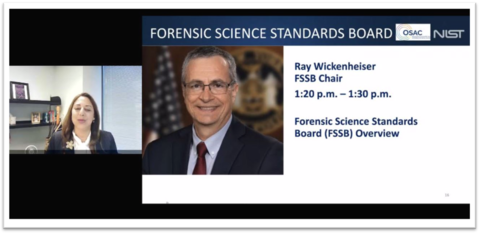Fall 2022 & Annual Report
Message from the Chair
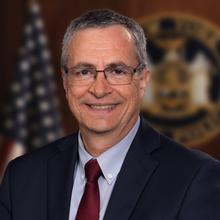
I am honored to serve as the Chair of the Forensic Science Standards Board (FSSB) for 2022-2023. The FSSB and OSAC are privileged to have dedicated volunteers who unselfishly donate their knowledge, skills, and passion towards the generation of proposed standards to improve forensic science. We are likewise very fortunate to be supported by a talented OSAC Program Office that excels at service and approachability. It is thrilling to work with such a combined professional group in a noble common purpose of establishing a sound framework to support objective data and results to further justice. Thank you for your ongoing effort and commitment!
While our focus remains on developing quality standards to populate the OSAC Registry, we are expanding our vision to include support for the implementation of standards. NIST’s current partnership with the American Academy of Forensic Sciences (AAFS) provides fact sheets and checklists to support the awareness, evaluation, and implementation of standards. Our Registry Implementation Survey and self-declarations from forensic science service providers help us better understand how standards on the OSAC Registry are being used. We have also commenced an Implementer Cohort Task Group, which will be working with mentors whose laboratories have implemented standards to share experiences and assist other laboratories with implementation. We are very excited to facilitate labs helping labs.
The FSSB has also supported the development of a Reporting and Testimony guidance document. This serves as a model and is the first of a potential group of multidisciplinary guidance documents, the next of which will be a Proficiency Testing guidance document. These guidance documents will provide a roadmap for OSAC subcommittees as they develop their work products.
We have also approved our Long Term Strategic Plan, which has now been solidified to include various milestones and deliverables. This plan will chart our progress in four key areas: Inclusion, Development of Standards, Implementation and Continuous Improvement.
Development and implementation of standards to improve forensic science are both a long term and worthy efforts. It is a consensus-based approach, which is made stronger by the inclusion of a wide variety of viewpoints. It also comes with compromise, where documents are frequently aspirational, and it will take time to build our systems based on continuous improvement. Thank you again for your selfless dedication to improving our field of forensic science!
Best regards,
Ray Wickenheiser, FSSB Chair
2022 OSAC Registry Implementation Survey: Preliminary Results

Background
The OSAC Registry Implementation Survey is a tool OSAC has used to assess the state of implementation of the standards on the OSAC Registry. The first survey, which was open from June 10, 2021 through August 31, 2021, provided a snapshot and assessment of 46 standards that were posted on the OSAC Registry through March 2021.
In June 2022, OSAC released its second survey which provided an assessment of 95 standards posted on the Registry through June 2022. This newsletter provides a preliminary look at the survey results. A detailed report, focusing specifically on the 20 disciplines and 95 standards represented in the survey, will be released in February 2023.
Data Analysis
OSAC received a total of 181 survey responses. Twenty-five responses from non-forensic science service providers (FSSPs) and foreign organizations were not included in the data analysis.
The survey requested one response be submitted per location. For example, a state or Federal laboratory with multiple laboratories was asked to provide one response for each laboratory system’s city, region, or district. The OSAC Program Office (OPO) reviewed any uncertain replies to determine if responses were intended for one or multiple locations.
Additionally, OPO also reviewed responses from those who indicated their organization had not implemented any standards on the OSAC Registry to determine if any were operational laboratories that were accredited. OPO validated that 17 of these 18 self-identified “non-implementers” are accredited, meaning they have implemented either ISO 17025 or ISO 17020 which are standards on the OSAC Registry. ISO 17025:2017 is the General Requirements for the Competence of Testing and Calibration Laboratories and ISO 17020: 2012 is Conformity Assessment—Requirements for the Operation of Various Types of Bodies Performing Inspection.
After reviewing and verifying any uncertain replies with the survey participants, OSAC was able to include 21 back into the survey, resulting in a total of 177 responses that were included in the data analysis.
Of the 177 survey respondents, 49 said their organization has not implemented any standards on the OSAC Registry, while 128 reported that their organization has fully or partially implemented standards on the OSAC Registry.
Respondents’ demographic information was evaluated to allow the results to be combined and sorted by organization. Data analyses were used to help visualize trends among the selections made by FSSPs, such as the number of standards implemented, level and priority of implementation efforts, and the key challenges encountered in implementation.
Respondent Demographics
Geographic Regions
The 177 respondents represented 40 states in the U.S. and the territory of Puerto Rico. Geographic region groups were used as defined by the U.S. census1. The Southern region of the U.S., which includes the South Atlantic, East South Central and West South Central divisions, was most heavily represented in the 2022 survey. The Western region, consisting of the Mountain and Pacific divisions, was the second most common region represented.
Geographic Regions: 2021 & 2022 Comparison
Thirty-eight states were represented in the 2021 survey. FSSPs represented 40 states in the 2022 survey including new representation from CT, VT, IA, NE, ND, MS, TN, MT, and PR.
The Southern and Western regions were the most represented areas in both the 2021 and 2022 surveys. See Table 1 for a comparison of regions and the number of respondents from the 2021 and 2022 surveys.
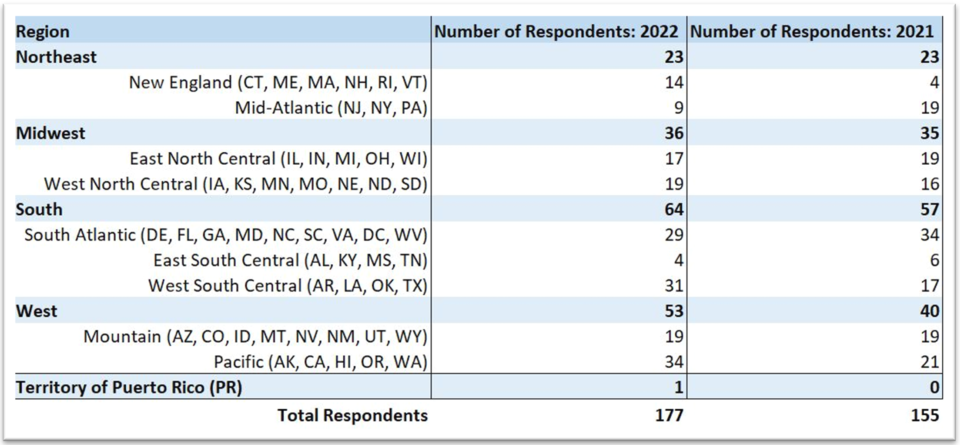
Organization Types
Of the 177 respondents, most were from U.S. state government organizations (41.8%) with the U.S. county government (23.2%) organization type being the second most common. Other U.S. organization types represented included city government (15.3%), private (15.3%), federal (2.8%), and academic (1.7%) organizations (Figure 1).
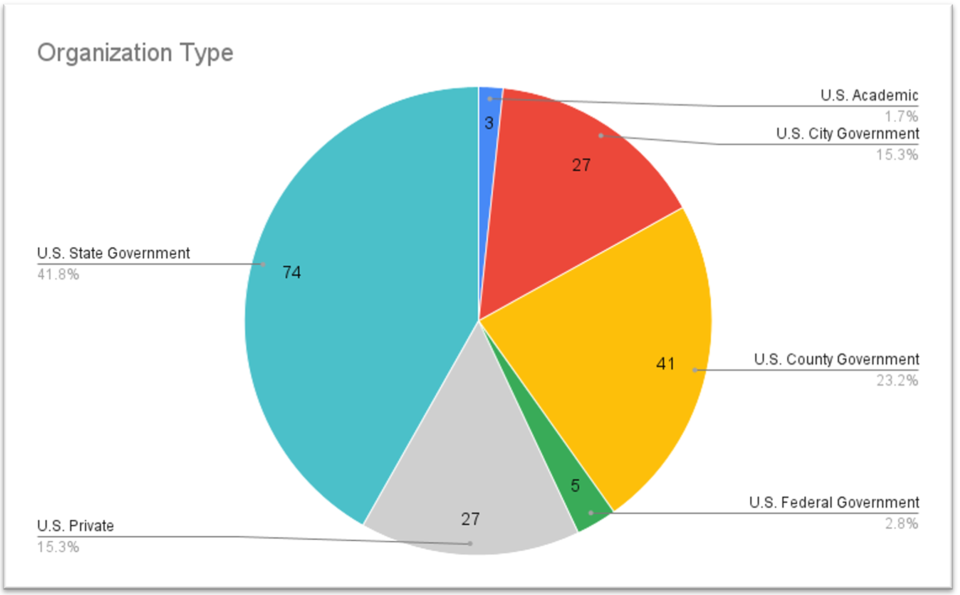
Organization Types: 2021 & 2022 Comparison
U.S. state government was the most represented organization type in both the 2021 and 2022 surveys. See Table 2 for a comparison of organization types represented in the 2021 and 2022 surveys.
| Organization Types | 2022 (177 respondents) | 2021 (155 respondents) |
|---|---|---|
| U.S. State Government | 41.8% | 47.1% |
| U.S. County Government | 23.2% | 18.7% |
| U.S. City Government | 15.3% | 15.5% |
| Private | 27% | 12.9% |
| Federal | 2.8% | 5.2% |
| Academia | 1.7% | 0.6% |
Respondent Roles
Of the 177 respondents, 32.8% were working as quality managers, followed by 30.5% working in a director or deputy role. Other positions represented included practitioners/examiners (18.6%), managers/section leaders (14.1%), and medical examiners/coroners - deputy medical examiners/coroners (4.0%) (Figure 2).
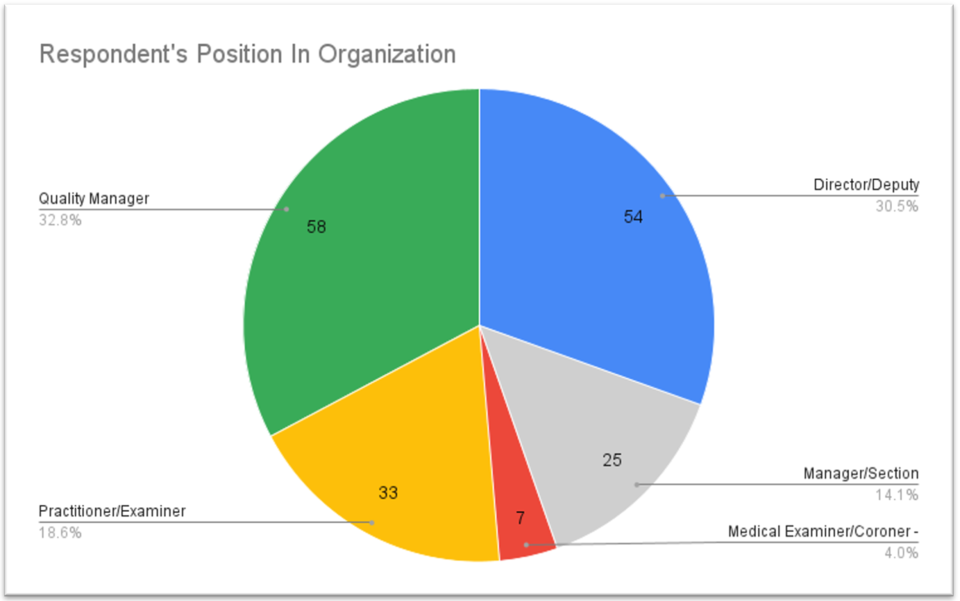
Respondent Roles: 2021 & 2022 Comparison
Quality Managers were the most represented role in both the 2021 and 2022 surveys. See Table 3 for a comparison of the roles represented in the 2021 and 2022 surveys.
| Respondent Roles | 2022 (177 respondents) | 2021 (155 respondents) |
|---|---|---|
| Director/Deputy Director | 30.5% | 37.4% |
| Quality Manager | 32.8% | 40.6% |
| Manager/Section Leader | 14.1% | 11% |
| Practitioner/Examiner | 18.6% | 9.7% |
| Medical Examiner/Coroner | 4% | N/A |
| Organization Owner | N/A | 1.3% |
OSAC Registry Awareness
Survey participants were asked whether individuals in their organization were aware of the OSAC Registry. Most respondents, 164 out of 177 (93%), acknowledged that individuals in their organization were knowledgeable of the standards on the OSAC Registry.
OSAC Registry Awareness: 2021 & 2022 Comparison
When asked this question in the 2021 survey, 153 out of 155 respondents (98%) were aware of the standards on the OSAC Registry (Figure 3).
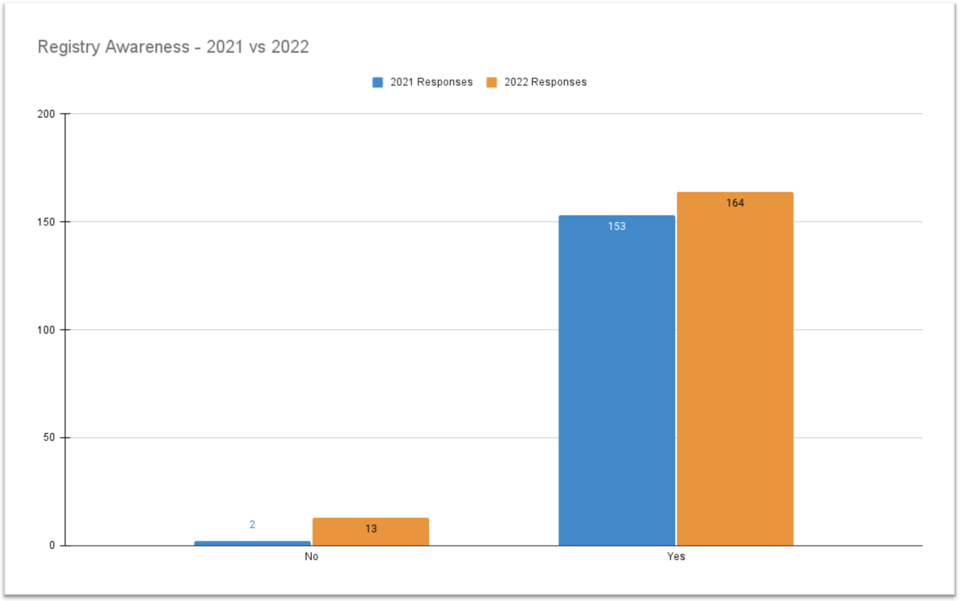
Priority for Standards Implementation
When asked what priority survey participants considered standards implementation for their organization, 43.5% said it was a high priority (very important) and 33.9% said it was a medium priority (important). Of the 177 respondents, 37 (20.9%) indicated that implementation was a low priority or not a priority at this time and three (1.7%) said implementation was not applicable for their organization (Figure 4).
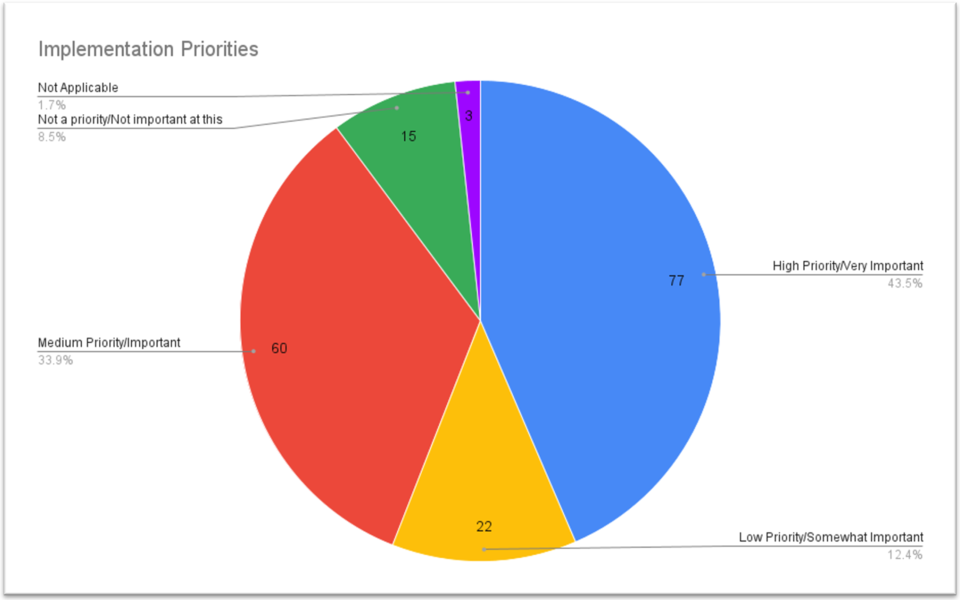
Priority for Standards Implementation: 2021 & 2022 Comparison
According to the 177 respondents to the 2022 survey, implementation was seen as a higher priority compared to the 155 respondents in the 2021 survey (Figure 5).
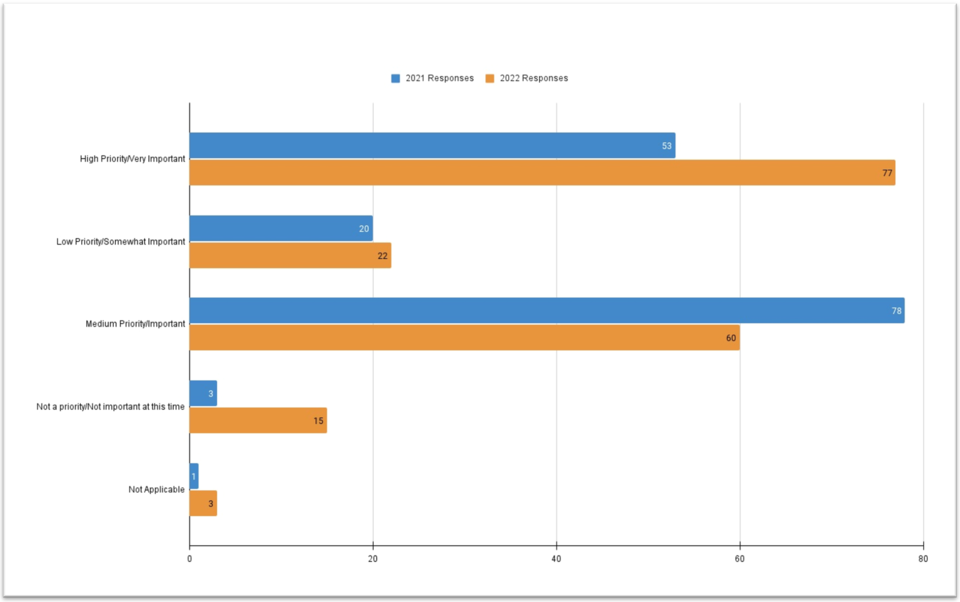
Key Challenges to Implementation
OSAC wanted to learn more about the challenges organizations faced when implementing standards on the OSAC Registry. Survey participants were asked to select up to five key challenges from a list of 14 options. From a total of 434 responses to this question, 70 indicated there were no major challenges and their organization supports implementation policies. See Table 4 for the complete list of key challenges and number of responses.
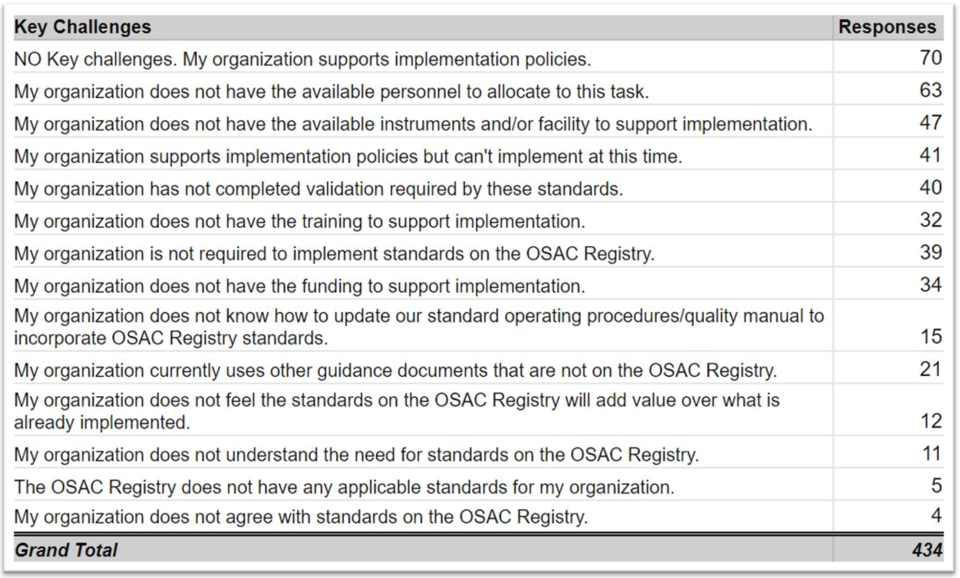
Organizations Participating in Full and Partial Standards Implementation
This survey assessed the state of implementation, either full or partial, of the 95 standards that were posted on the Registry through June 2022. Of these, 79 were SDO published and 16 were OSAC Proposed Standards.
Of the 177 survey respondents, 49 indicated that they have not implemented, either fully or partially, any of the standards on the OSAC Registry. The remaining 128 respondents (referred to as “implementers” in the rest of the report) have either partially or fully implemented at least one standard on the OSAC Registry.
All 79 SDO published standards and 15 OSAC Proposed Standards have been implemented, either fully or partially. Only one OSAC Proposed standard, OSAC 2021-N-0009, Standard Practice for the Collection and Preservation of Organic Gunshot Residue Analysis, has not yet been implemented in any organizations represented by the survey respondents.
Full or Partial Implementation: Published Standards
As mentioned above, all 79 SDO published standards represented in this survey have been implemented, either fully or partially. The SDO published standard that has been implemented the most by organizations is ISO/IEC 17025:2017 General Requirements for the Competence of Testing and Calibration Laboratories. This standard specifies the general requirements for the competence, impartiality, and consistent operation of laboratories and is a key standard used to accredit forensic laboratories. Of the 128 implementers, 91 have implemented ISO 17025:2017, either fully or partially.
After ISO 17025:2017, the standard that was implemented the most was ASTM E2917-19a, Standard Practice for Forensic Science Practitioner Training, Continuing Education, and Professional Development. This standard provides foundational requirements for the training, continuing education and professional development of forensic science practitioners to include training criteria toward competency, documentation, implementation of training, and continuous professional development. Of the 128 implementers, 87 have implemented ASTM E2917-19a, either fully or partially.
The discipline-specific standards that have been implemented the most are in the seized drugs discipline and include ASTM E2329-17, Standard Practice for Identification of Seized Drugs and ASTM E2548-16, Standard Guide for Sampling Seized Drugs for Qualitative and Quantitative Analysis. Of the 128 implementers identified in this survey, 67 have implemented ASTM E2329-17 and 65 have implemented ASTM E2548-16, either fully or partially.
See Figure 6 for the top 10 implemented SDO published standards represented in this survey.
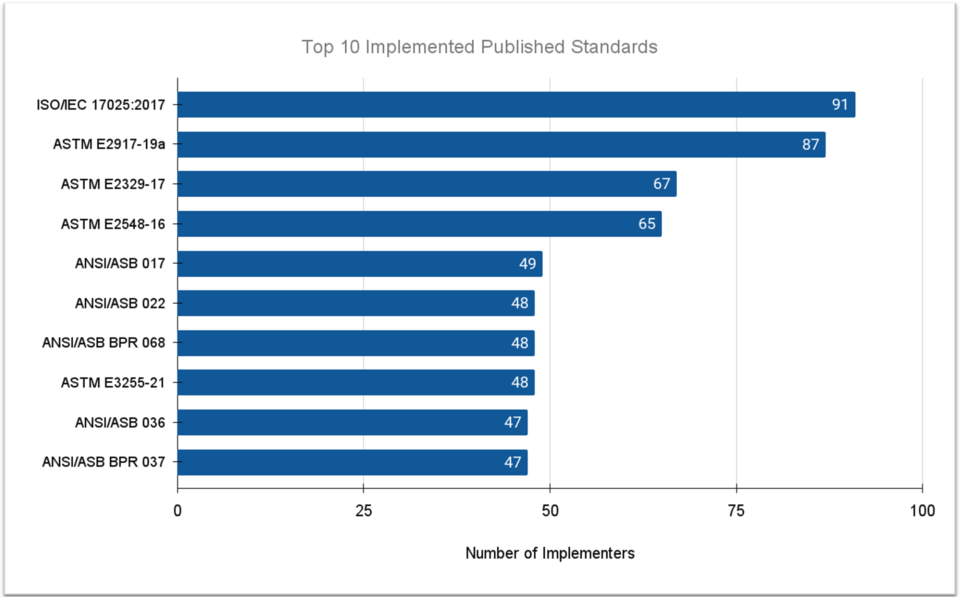
Full or Partial Implementation: OSAC Proposed Standards
Of the 16 OSAC Proposed Standards represented in this survey, only OSAC 2021-N-0009, Standard Practice for the Collection and Preservation of Organic Gunshot Residue Analysis, has not yet been implemented in organizations.
Of the OSAC Proposed Standards on the Registry, two friction ridge standards have been implemented the most. The first, OSAC 2022-S-0012, Standard for Proficiency Testing in Friction Ridge Examination describes the minimum requirements for the selection, development, validation, administration, evaluation, and documentation of proficiency tests to assess the performance of personnel and the overall quality system of a forensic service provider related to friction ridge examination. Of the 128 implementers, 33 have implemented this standard, either fully or partially.
The second most implemented OSAC Proposed Standard, OSAC 2021-N-0020, Best Practice Recommendations for Limited Friction Ridge Examinations, describes what limited examinations are and provides the best practice recommendations on how limited examinations should be conducted. Of the 128 implementers, 31 have implemented this OSAC standard, either fully or partially.
There were no SDO published standards available for the friction ridge discipline at the time of this survey. Perhaps this is the reason that the survey results support the observation that these friction ridge OSAC Proposed Standards were the most implemented.
See Figure 7 for the number of respondents that have indicated full or partial implementation of the 16 OSAC Proposed Standards in this survey.
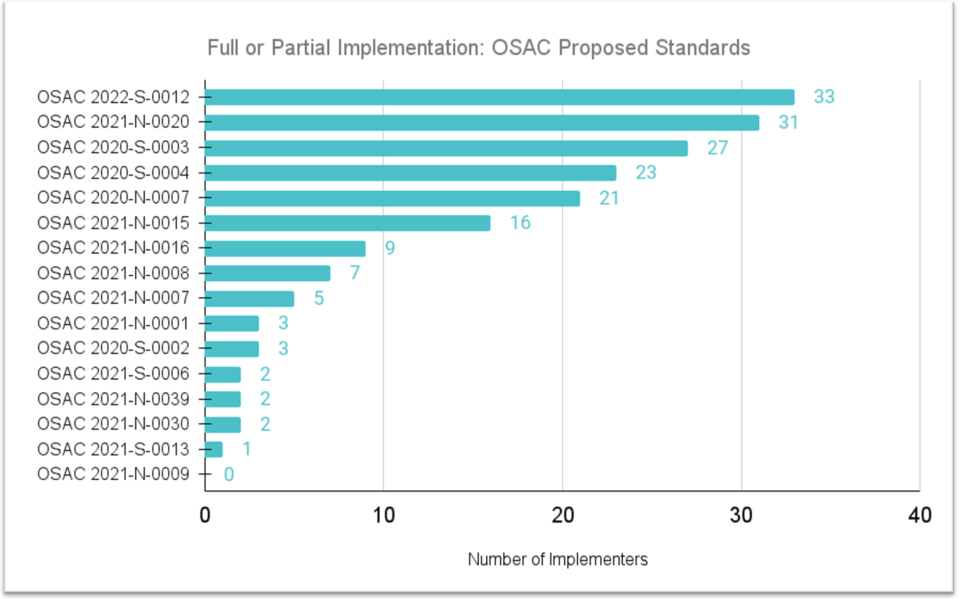
Key Takeaways from the 2022 Initial Survey Data
-
128 forensic science service providers have implemented standards on the OSAC Registry. Of the 95 standards included in this survey, 94 are being implemented.
-
Survey responses represent forensic science service providers from 40 states and the territory of Puerto Rico, and across a range of organization types, roles, and geographical regions.
-
93% of the survey respondents are aware of the standards on the OSAC Registry.
-
44% of the survey respondents consider implementation a high/very important priority.
-
Survey responses identified the top key challenges to implementation as not having personnel to allocate to the task and not having the instruments and/or facility to support implementation.
OSAC will be publishing a detailed report in February 2023 which will provide specific implementation information on each the 95 standards and 20 disciplines represented in the 2022 survey.
[1] REGIONS AND DIVISIONS TAKEN FROM U.S. CENSUS BUREAU: HTTPS://WWW2.CENSUS.GOV/GEO/PDFS/MAPS-DATA/MAPS/REFERENCE/US_REGDIV.PDF
OSAC Registry Implementation Updates
OSAC Expands Outreach to Non-Traditional Laboratories
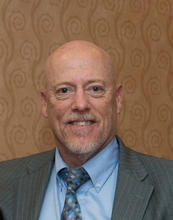
Courtesy of Steve Johnson, Outreach Contractor, OSAC Program Office
As part of the OSAC mission to strengthen “the nation's use of forensic science by facilitating the development of technically sound standards and guidelines and encouraging their use throughout the forensic science community”, the leadership of the organization has been reaching out to community stakeholders to encourage implementation of standards that have made it through the vetting process and are on the OSAC Registry. To increase this outreach effort, the OSAC Program Office (OPO) has added a non-traditional outreach contractor to their team to engage with those FSSPs that fall outside the 410 currently recognized laboratories. These non-traditional FSSPs represent thousands, if not tens of thousands, of small forensic operations that may only provide examination or analysis support in one or a few disciplines. Many of these non-traditional FSSPs are extensions of law enforcement agencies but a good number of them are privately owned and operated. OSAC believes these non-traditional FSSPs are significant stakeholders in the standards development and implementation effort and providing a resource to initiate communication and open channels to the organization is the next, best step to building the enterprise. I am fortunate and am honored to act as that representative to the OPO.
Among the disciplines that are often under-represented or (possibly) overlooked in the non-traditional realm are latent print examination, facial examination, footwear examination, firearms/tool mark examination, crime scene investigation and digital evidence (among others). Of these, perhaps the most widespread from a non-traditional FSSP perspective is digital evidence. As many of you know, digital evidence was not part of the original OSAC structure and came to the table nearly a year after the launch of OSAC in 2014. Since then, the Digital Evidence Subcommittee has been an active member of the OSAC team. There is an estimated 11,000 digital evidence FSSPs in the United States. Trying to identify and communicate with all of them to encourage standards implementation will be a daunting task. A part of my duties as an standards implementation advocate, I will be working with OSAC’s Digital Evidence Subcommittee and the Scientific Working Group for Digital Evidence (SWGDE) to identify interested stakeholders and open some lines of communication.
Latent prints, footwear/tire track, firearms, and bloodstain pattern examination are traditional law enforcement forensic support services and have histories that go back decades (e.g., over 100 years for latent prints!). Many law enforcement agencies still have small, non-traditional FSSP operations that include these (and other) disciplines, and they will be a target of OSAC’s expanded outreach efforts. In my experience as a crime laboratory manager for a medium-sized, metropolitan law enforcement agency, I understand the challenges these labs face achieving and maintaining the high standards of operation that are expected from FSSPs in today’s environment. Being an advocate for these operations with that experience as a guide, I feel I can be a valuable conduit of information regarding the values of standards implementation.
Pursuant to my duties as an implementation advocate, I will be reaching out to laboratories, organizations, associations and other FSSPs and stakeholders to spread the word about the OSAC mission. It is hoped that this opportunity to expand our outreach will grow our list of “implementers” at a much greater rate. As a past member and chair of the OSAC Forensic Science Standards Board and a current member of the Facial Identification Subcommittee, I understand the importance and value of our mission. I am open to suggestions on who or what organization/agency may be interested in OSAC and standards adoption, and I invite any of you to reach out to me with recommendations for points of contact or potential partners.
I recently returned from Bogota, Colombia on a separate (but equally important) mission in support of the forensic sciences. I was asked to present at the inaugural educational conference of the Colombian Division of the International Association for Identification (IAI) and was impressed and encouraged by the thirst for knowledge and devotion to the forensic sciences that was on display at this event. That devotion included interest in OSAC and a desire to attain a high-level of professionalism and utilizing scientifically based guidelines and standards in their labs across Central and South America. In more than one presentation, OSAC was mentioned as a valuable resource for their agency or organization. We should take some serious pride in knowing that the work we are doing is bearing fruit, not only in the U.S. but around the world. I hope I can continue this mission and build bridges between OSAC and the non-traditional FSSPs and appreciate your support as that effort engages in the coming year.
OSAC News
FSSB Member Appointments: FY 2023
This past fall, the FSSB approved the following FSSB Executive Task Group and new FSSB members for FY 2023. These individuals began their roles on October 1, 2022.
FSSB Executive Task Group Members:

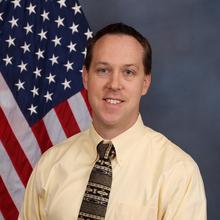

New FSSB Members:
- Sally Aiken, National Association of Medical Examiners (NAME) representative
- Elissia Conlon, New York City Office of Chief Medical Examiner Office, Medicine SAC chair
- Lynn Garcia, Texas Forensic Science Commission, FSSB liaison to Legal Task Group
- Marcela Najarro, NIST, FSSB NIST Ex Officio
To see all the current members of OSAC’s FSSB, visit the FSSB webpage on the OSAC website.
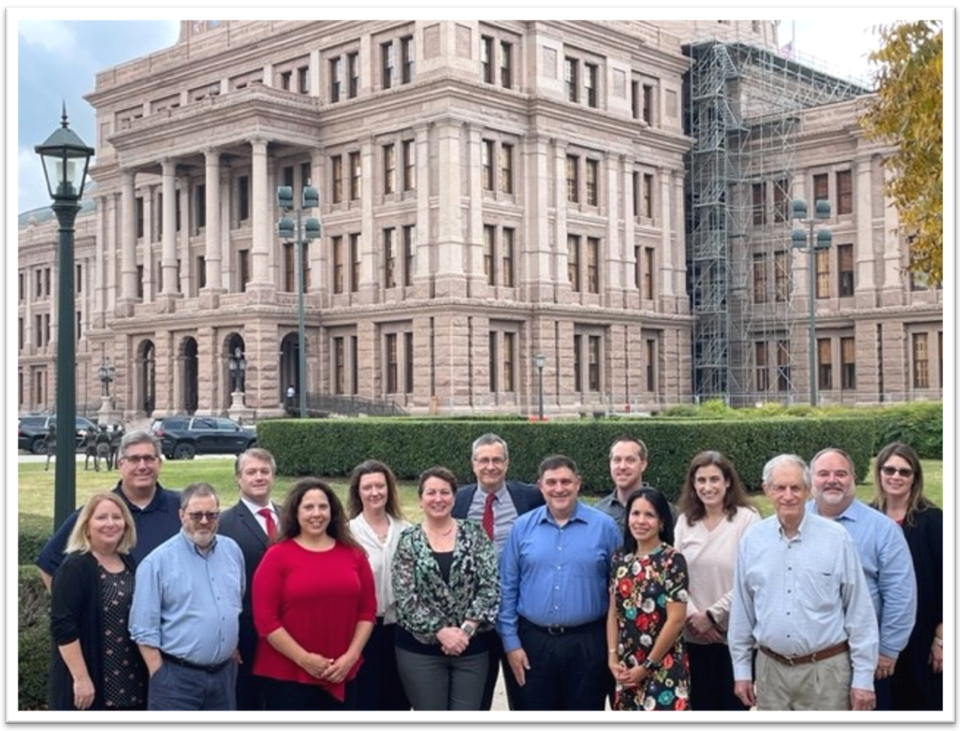
OSAC Awards
The following individuals and group were recognized for their outstanding and extraordinary efforts in furthering OSAC’s mission. The award recipients were announced and presented with a certificate at the spring 2022 OSAC Meetings or at the OSAC Leadership Strategy Session (OLSS) held this past September.
Distinguished Individual Service Award
- Julie Carnes, current affiliate and past VITAL Subcommittee Chair
- Brian Higgins, past Human Forensic Biology Subcommittee Vice Chair
- Kelly Keyes, Medicolegal Death Investigation Subcommittee Chair
- Ryan Lilien, Member of the Firearms & Toolmarks Subcommittee
- Kimberlee Moran, Crime Scene Investigation & Reconstruction Subcommittee Executive Secretary
- Lori Nix, Member of the Facial Identification Subcommittee, Quality Task Group representative, and FSSB Terminology Task Group Chair
- Jennifer Remy, Member of Trace Materials Subcommittee, Quality Task Group representative, and ASTM representative for hairs/fibers
- Anne Slaymaker, Drugs Subcommittee past Executive Secretary and current Vice Chair
Outstanding Group Award
OSAC’s Human Forensic Biology Subcommittee was recognized for their outstanding work efforts in furthering OSAC’s mission.
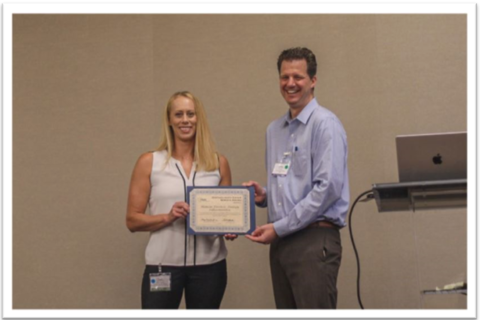
Sharon B. Nakich Award
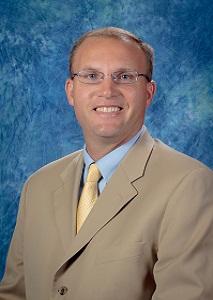
Matthew Gamette was the recipient of the 2022 Sharon B. Nakich Award. In honor of our colleague, Sharon Nakich, this OSAC peer-to-peer award acknowledges a helpful attitude, kindness, teamwork, or behind-the-scenes contributions to support the goals of OSAC. It recognizes an individual who has made significant contributions to promote OSAC’s mission through their support of OSAC. This nominee works diligently and tirelessly as a champion for OSAC, at times without recognition.
Matthew is the current Laboratory Systems Director, Idaho State Police Forensic Services, the chair of the Consortium of Forensic Science Organizations (CFSO) and past president of the American Society of Crime Laboratory Directors (ASCLD).
He served as one of the original members of the Quality Infrastructure Committee (QIC), beginning in 2014, as one of the five ASCLD representatives. Matthew was instrumental in establishing many of the original procedures, structures, and methods of OSAC. Specifically, he was the original chair and still is on the OSAC 29 Terms Task Group, now called the OSAC Preferred Subtask Group of the FSSB’s Terminology Task Group. After Matthew’s two terms on the QIC ended, he stayed on as an affiliate. Establishing terminology was and is a monumental task given the many disparate definitions of scores of the most common forensic and quality terms used by different agencies, bodies, guidelines, and standards. Matthew has been a driving force for the consistent use of consensus terms.
Matthew also volunteers his time as Chair of the Consortium of Forensic Science Organizations (CFSO) that is active in educating stakeholders on the value of forensic science and forensic science standards.
Matthew is one of OSAC’s biggest supporters and has contributed greatly to its success. His outstanding volunteer activities stand out as above and beyond. He has shown he is committed long term, to furthering and supporting the mission of OSAC and the field of forensic science.
OSAC: A Year in Review
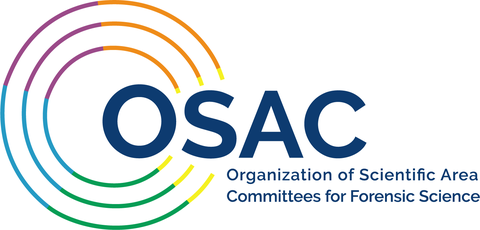
In addition to delivering quarterly updates, the fall edition of the OSAC Newsletter also serves as OSAC’s annual report and provides a review of OSAC’s accomplishments and activities over the past fiscal year, October 1, 2021, through September 30, 2022.
Organizational Snapshot
In February 2022, OSAC entered its eighth year of existence and currently includes:
- 480+ members
- 390+ active affiliates
- 1,800+ member and affiliate applications
The employer and job classification of OSAC members include:

OSAC Registry
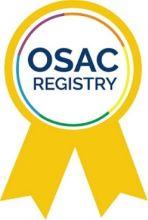
The OSAC Registry reached a milestone this past August as the 100th standard was added!
The 100th and 101st standards added to the Registry were ANSI/ASB Standard 062, Standard for Topography Comparison Software for Toolmark Analysis and ANSI/ASB Standard 063, Implementation of 3D Technologies in Forensic Firearm and Toolmark Comparison Laboratories. These two firearm and toolmark standards provide guidance on purchasing, setting up, and implementing 3D systems. Read more about the impact of these standards in this NIST news release.
The first standards for the friction ridge discipline were also added to the Registry in FY 2022. These standards included:
- OSAC 2021-N-0020, Best Practice Recommendations for Limited Examinations
- OSAC 2022-N-0033, Standard for Processing Evidence for the Detection of Friction Ridge Impressions
- OSAC 2022-S-0012, Standard for Proficiency Testing in Friction Ridge Examination
- ASTM E3235-21, Standard Practice for Latent Print Evidence Imaging Resolution (this standard was drafted by OSAC’s VITAL Subcommittee but is applicable to the friction ridge discipline).
In addition, a notable standard for the forensic toxicology discipline was added to the Registry in September. This standard, ANSI/ASB Standard 120, Standard for the Analytical Scope and Sensitivity of Forensic Toxicological Testing of Blood in Impaired Driving Investigations, establishes the various substances a forensic toxicology laboratory must be able to identify, as well as appropriate detection levels when testing blood samples from impaired driving investigations. Read more from Marc LeBeau, chair of the Chemistry: Seized Drugs & Toxicology SAC, Sarah Kerrigan, member of OSAC’s FSSB and forensic toxicologist about the importance of this standard.
The OSAC Registry continues to grow, and during FY 2022 OSAC added 36 additional standards to the Registry. At the end of FY 2022 the OSAC Registry contained 108 standards (89 published and 19 OSAC Proposed), representing over 20 specific forensic science disciplines and various interdisciplinary topics (Figure 8).
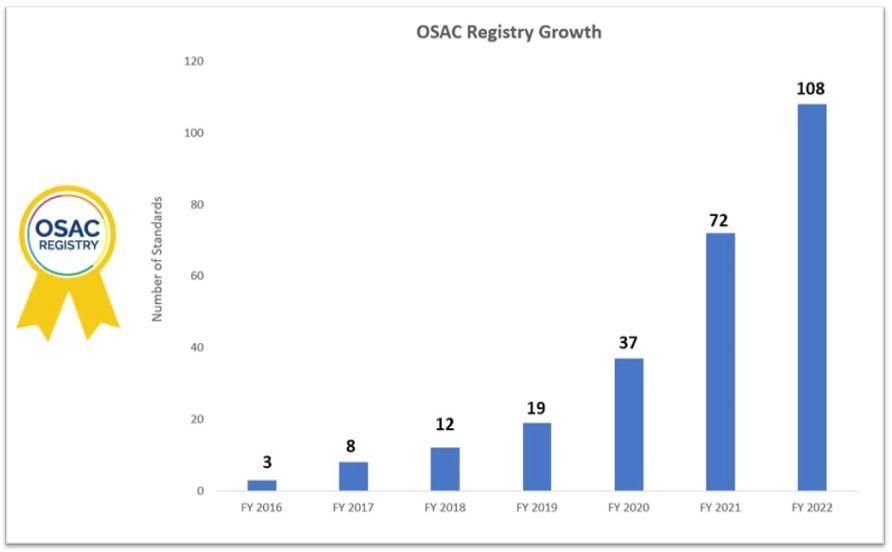
To see a current list of standards on the OSAC Registry and a breakdown of standards by fiscal year, visit the OSAC Registry webpage.
Registry Implementation Efforts
OSAC continued to focus its implementation efforts on traditional forensic science service providers (FSSPs) this past fiscal year, in addition to expanding its outreach to non-traditional FSSPs as mentioned above.
At the end of FY 2022, OSAC had received a total of 96 Registry Implementation Declaration Forms from FSSPs across the county and internationally, 49 of which were submitted during FY2022. These declarations include:
- 61 state laboratory locations (representing 12 states)
- 23 local/county/city laboratories
- 4 Federal laboratories
- 4 private laboratories
- 2 university laboratories
- 2 international laboratories
If your organization has implemented any of the standards on the OSAC Registry, let us know! Complete the Registry Implementation Declaration Form and send it to mark.stolorow [at] nist.gov (mark[dot]stolorow[at]nist[dot]gov) to join the other OSAC Registry Implementers!
FY 2022 OSAC Standards Activities
There are over 450 standards moving through OSAC’s processes! Here’s a snapshot of OSAC’s standards activities at the end of FY 2022:
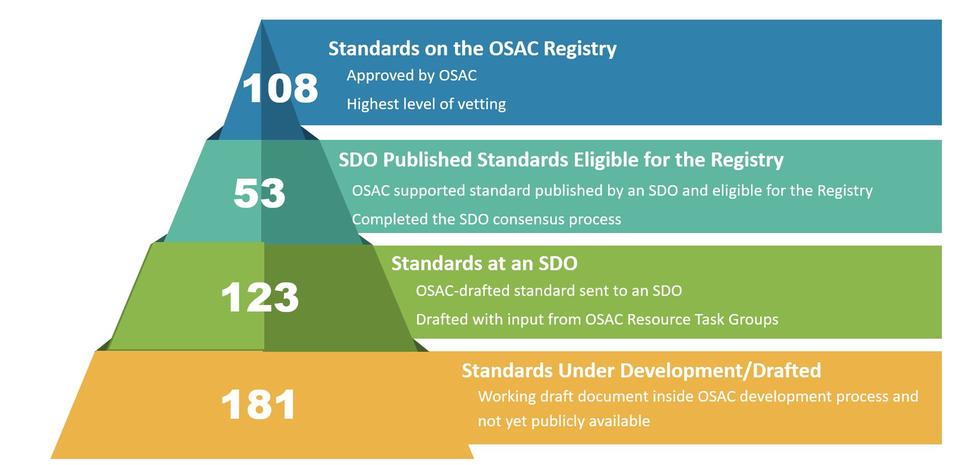
Other Highlights & Accomplishments
In addition to growing the Registry and facilitating standards activities, here are some other highlights and accomplishments from FY 2022:
- NIST & AAFS Cooperative Agreement: In October 2021, NIST entered into a cooperative agreement with the American Academy of Forensic Sciences (AAFS) to develop tools, training, and resources to broaden awareness of forensic science standards and assist with standards implementation efforts. Standards factsheets are currently available for 45+ standards on the OSAC Registry and provide a clear, concise, and easy way to understand the purpose of a specific standard, why it is needed, and the benefits of implementation. Standards checklists are currently available for 50+ standards on the OSAC Registry and are a tool that forensic science service providers can use to track progress towards implementation, identify gaps or barriers to implementation, or document objective evidence of implementation or compliance with a standard. Standards webinars and training videos are available for free from AAFS Connect. Learn about the standards development process, standards development activities in various disciplines, and information about specific SDO published standards on the OSAC Registry.
- NIST’s Special Program Office (SPO) receives AAFS Ambassador of Forensic Science Award. NIST’s Forensic Science Program, within SPO, works to strengthen the scientific basis of forensic methods and practices through research, foundation studies and standards development and implementation. Members of the NIST team accepted the AAFS Ambassador of Forensic Science Award at the AAFS Annual Meeting in Seattle, WA on February 23, 2022.
- OSAC All-Hands Meetings: After two years of virtual meetings, OSAC members were able to meet in-person again in Orlando, FL to continue their work on standards development. In spring of 2022, OSAC hosted three All-Hands Meetings. The Scene Examination SAC and Physics/Pattern Interpretation SAC and their subcommittees met May 16-20, the Medicine SAC and Digital/Multimedia SAC and their subcommittees met May 23-27, and the Biology SAC, Chemistry: Seized Drugs & Toxicology SAC, and Chemistry: Trace Evidence SAC and their subcommittees met June 13-17.
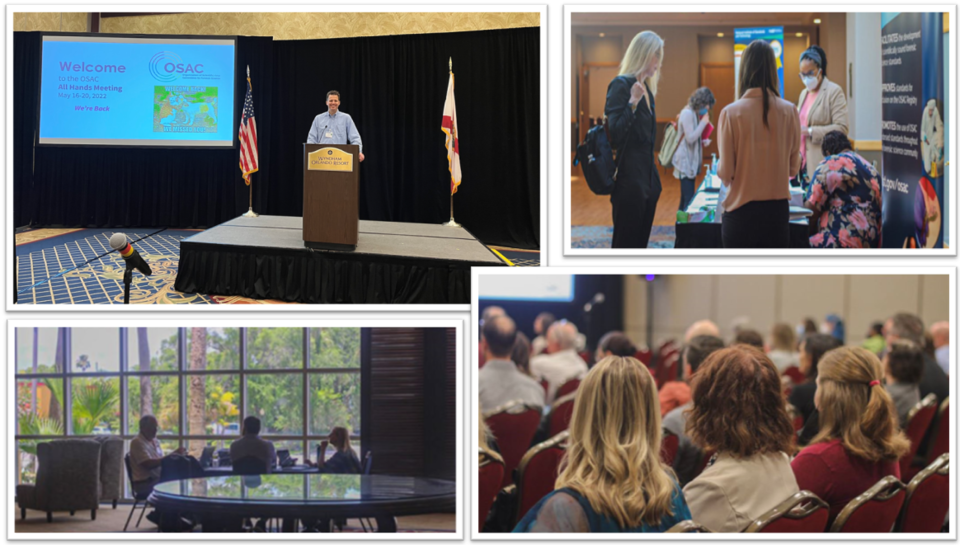
- Two New Process Maps Published: Along with drafting and approving standards for the OSAC Registry, OSAC also develops and shares other work products that support standards development and implementation. One type of work product, process maps, are a useful tool that can help forensic disciplines provide insight into their specific activities, identify areas for improvement, and identify where standards may be needed. The following two new process maps were published in FY 2022:
- Human Forensic DNA Analysis – May 2022
- Footwear & Tire Examination – June 2022
- OSAC Registry Implementation Survey: In June 2022, OSAC launched its second Registry Implementation Survey. This survey assessed the state of implementation of 95 standards posted on the OSAC Registry through June 2022. Of the 177 responses included in the data analysis, 128 forensic science service providers reported that their organization has fully or partially implemented at least one standard on the OSAC Registry.
-
Karen Reczek, former FSSB NIST Ex Officio and moderator for the 2022 OSAC Public Update Meeting, introducing Ray Wickenheiser, FSSB Chair, for his update from the FSSB OSAC Public Update Meeting: Each year, OSAC reports its activities in an open and online public forum and provides an opportunity for the public to ask questions and provide feedback. Over 400 people, tuned in to this year’s Public Update Meeting on September 13. During this virtual event, Ray Wickenheiser, FSSB chair, provided updates from the FSSB, and each of OSAC’s seven SAC chairs shared their unit’s activities and priorities for the upcoming year.
- OSAC Leadership Strategy Session: On September 20, 2022, OSAC leaders came together (virtually) at the OSAC Leadership Strategy Session (OLSS) to review their priorities and accomplishments and share challenges and lessons learned from this past year. OSAC subcommittees also shared their goals and priorities for FY 2023.
- OSAC Long Term Strategic Plan: The FSSB developed and approved OSAC’s Long Term Strategic Plan which describes objectives, deliverables, and metrics for four focus areas: inclusion, development of standards, implementation, and ongoing improvement. This plan was initially approved at the OLSS in September and further refined and approved in December 2022.
- Improved Access to ASTM Standards: OSAC has worked with ASTM to improve access to the E30 (forensic sciences) collection of standards. Through an agreement with ASTM, the public now has free access to these documents through the OSAC Registry webpage.
- Research and Development Needs: OSAC subcommittees continue to review and identify new research and development needs. Academic institutions, federal agencies, and other research organizations can access the 170+ R&D needs on the OSAC website to help address technical challenges identified by forensic science service providers.
- Digital Communications Outreach: OSAC continued to grow our digital communications presence, as evidenced by an increase in website views, downloads, and LinkedIn posts and followers. As our outreach grows, so does our ability to reach more stakeholders and educate the forensic science community about new standards being developed and championed by OSAC.
Other Outreach Events
OSAC members, affiliates, and OSAC Program Office staff gave over 50 OSAC-related presentations at various forensic science conferences and meetings this fiscal year, some of which included:
- Association of Forensic Quality Assurance Managers (AFQAM) Annual Training Conference, October 2021.
- AAFS Annual Scientific Meeting, February 2022. There was an abundance of standards-related presentations and OSAC participation at the 2022 AAFS Meeting!
- 2022 American Society of Crime Laboratory Directors (ASCLD) Symposium, April 2022.
- International Association for Identification (IAI) Annual Conference, August 2021.
Along with giving presentations, OSAC was able to share information and engage with the forensic science community through these other activities:
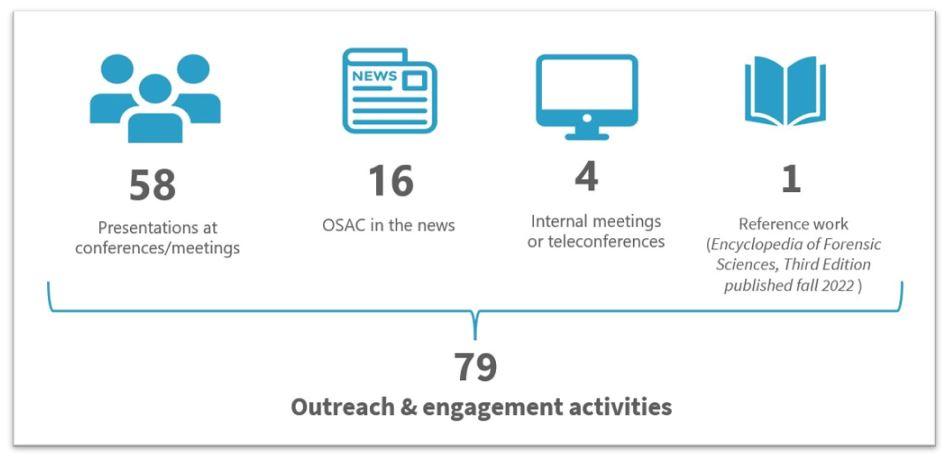
Final Words
OSAC continues to make great strides to help facilitate the development and implementation of technically sound and consensus-based forensic science standards. With almost 800 combined members and affiliates representing forensic science practitioners, laboratory managers, academic researchers, measurement scientists, and experts in statistics, human factors, legal, and quality infrastructure, we will continue to work together to strengthen forensic science through standards.
The FSSB and OSAC Program Office would like to thank all OSAC volunteers for their time and effort and all the federal, state, and local government agencies, academic institutions, and criminal justice and forensic science organizations that support the OSAC mission by supporting their staff to participate.
OSAC & Other Forensic Science Events
2023
February 13-18: 2023 AAFS Annual Scientific Meeting, Orlando, FL. There will be plenty of OSAC participation, standard-related presentations, and a NIST exhibit booth featuring OSAC at this year’s AAFS meeting! Check the program information and mark your calendars!
April 17-21: OSAC Meetings for the Physics/Pattern Interpretation, Scene Examination, and Chemistry: Trace Evidence SACs and subcommittees.
April 30-May 4: 2023 ASCLD Symposium, Austin, TX. Hear from the OSAC Program Office as they share tips on how to “Eat the Standards Implementation Elephant” and be sure to attend the other standard-related presentations happening throughout the week.
May 15-19: OSAC Meetings for the Digital/Multimedia, Medicine, Biology, and Chemistry: Drugs/Toxicology SACs and subcommittees.
NIST Research Activities
FORENSICS@ NIST
On November 8-10, 2022, NIST scientists shared how they are using advanced methods in metrology, computer science, and statistics to strengthen forensic science. The recorded sessions from the 2022 FORENSICS@NIST event are available on the NIST website.
Bitemark Analysis: A NIST Scientific Foundation Review
The National Institute of Standards and Technology (NIST) has reviewed the scientific foundations of bitemark analysis, a forensic technique in which marks on the skin of a biting victim are compared with the teeth of a suspected biter. View the full draft report and the comments received as part of the public comment period on the NIST website.
NIST Publishes Digital Evidence Foundations Report
This report documents the scientific foundations of digital evidence examination and recommends ways to advance the field.
Forensic Seized Drug Analysis Interlaboratory Study Engagement Survey
Several groups at NIST are working on developing a series of interlaboratory studies to support the forensic seized drug community. To prepare for these studies, information about the current technology and needs of the community is needed. Forensic practitioners actively involved in seized drug analysis are invited to participate in this six-question survey which is intended to gauge interest in the first two planned studies and better define the direction for future studies. The survey will close February 28, 2023.


